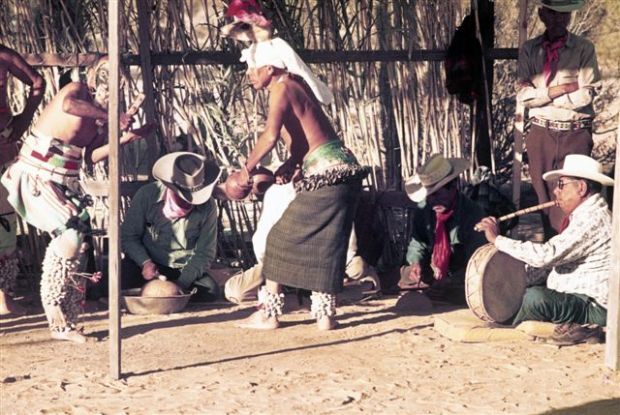Palm Sunday has come and gone, and Tucson’s Yaqui communities are beginning the culminating days of their annual Easter Ceremony. In my last blog I set the stage for you, so I’ll just cut to the chase. And a chase it is, with the Fariseos and Chapayekas seeking to capture and crucify Christ. They succeed, only to be finally defeated on Holy Saturday. Correction: I wrote the previous blog from memory. The group I called the “Soldiers of Rome” is more properly called the Caballeros. They march with the Fariseos, but on Good Friday evening they join the side of the church.
Put simply, the order of events is this: Sometime in Thursday afternoon, a Chapayeka wearing an Old Man mask leads the other Chapayekas around the Way of the Cross. This prefigures the sufferings of Jesus. Later on that evening, in a cottonwood bower in the plaza representing the Garden of Gethsemane, a statue of Jesus is captured, loosely tied, and carried to the church by the Fariseos. They keep guard over Him that night.
About noon on Good Friday, a procession leaves the church. At the first cross the men and women separate, to meet at Calvary, the eleventh cross. At this point Jesus is symbolically crucified. Later in the afternoon, Jesus, who has been tied to the processional cross and taken into the church, is symbolically lanced. The Chapayekas then uproot all the crosses on the Way of the Cross, and place leaves over them.
On Holy Saturday, the Fariseos hold a final procession in the late morning. They form two lines in front of the church. With the Chapayekas clacking their swords and daggers together, they march towards what they think will be their final victory. After a while the church bell rings, they charge the church, and are beaten back in a barrage of leaves and confetti. Three times they charge, three times they are repulsed. After the third time they remove their masks and are led by their godparents into the church for rededication. A fiesta, much like that of Palm Sunday, begins and lasts all night.
On Easter Sunday morning, all the participants hear a sermon describing their ritual work, thank each other, and go home for well-earned sleep.
A few words: The flowers and leaves that appear all through the ceremony are considered by Yaquis to be blessings, tangible manifestations of God’s grace. Jesus’ blood turned into flowers when He shed it on the Cross. The confetti which we as spectators are allowed to throw at the charging Fariseos are flowers. By attending the ceremony we become participants, and can add to or detract from it by our actions and attitudes. And remember, the only data retrieval systems permitted are your eyes, ears, and memory. Finally, expect to wait until everything is ready. The ceremony is not put on for an audience, but for God, who exists out of time, and is felt to be mostly concerned that everything is done correctly.
And I urge you to read Muriel Thayer Painter’s A Yaqui Easter, Tucson: The University of Arizona Press.





